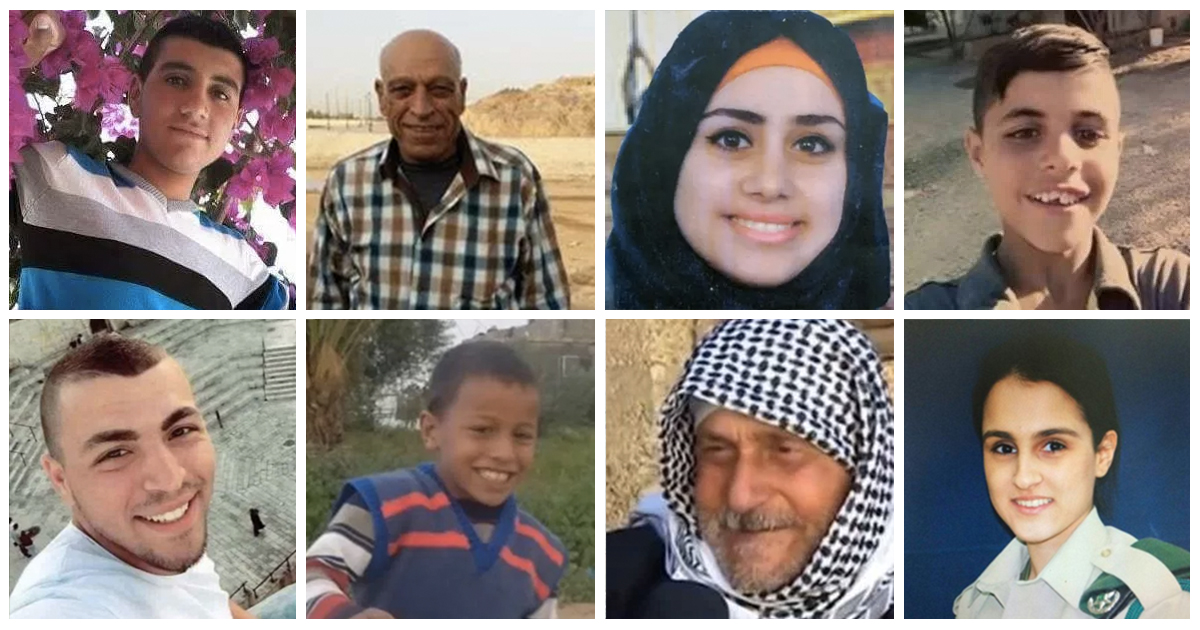| Donate | Contact Us | Materials | Subscribe | Israel-Palestine Timeline | Israel-Palestine News | |
 |
|
Israeli video games in Gaza
|
||||||||||||||||||||||||||||||||||||||
Israeli Video Games in Gaza |
 |
He looks at the camera with bright eyes and the beginning of a smile, wearing a miniature dark blue zipper sweatshirt, the cuffs folded up a bit to make it fit.
I can imagine his mother dressing him that morning, making sure he would be warm enough. I wonder if she’s the one who took the picture. Someone has written on the photo “kisses.”
Alison Weir is president of the Council for the National Interest and executive director of If Americans Knew. She can be reached at contact@ ifamericans knew.org. |
It’s not a formal picture. He’s outside on a sunny day. It looks like he was probably moving when the picture was snapped; his arms seem to be swinging a little. As with most almost two-year-olds, I suspect it was hard to get him to stay still long enough for a photo.
It’s a happy picture, the kind that makes you smile; perhaps it reminds you of funny, energetic little children you know or remember.
Until you see the next picture. It was taken on his second birthday. His name was Islam Quraiqe'.
Death from a drone strike is not pretty. The small body is charred, ripped apart; internal organs are pouring out (view the graphic photo).
He had been riding with his father and uncle on a motorcycle in Gaza when the missile hit them. His 29-year-old father, a member of the Palestinian resistance, and 32-year-old uncle physician were also killed. Five bystanders, including a woman, were injured.
The missile was fired remotely by an Israeli sitting in front of a video screen and operating one of the many drones that periodically fly over Gaza and shoot Palestinians like fish in a fishbowl. The operators are usually female, the preferred group for this kind of desk job.
The drones, which look like small, pilotless jets, are equipped with precision-guided missiles.
Those operating them receive real-time video feeds from sensors located on the drone: a color nose camera, a TV lens, an infrared camera for low light and night, and a synthetic radar for looking through smoke, clouds or haze. The cameras produce full motion video as well as still frame radar images.
Numerous articles extol the virtues of Israeli drones. An August 17th article by David Rodman reports: “The Israel Air Force (IAF) has a rich history of employing unmanned aerial vehicles in battle with excellent results.” Rodman crows that with the possible exception of the United States, “Israel is the country most closely identified with [drone] operations in the post-World War II period.”
Islam was the second two-year-old to be killed by Israeli forces in two days.
The first was killed by an Israeli “precision” rocket the day before. The boy’s name was Malek Sha’at. His father was also killed. The only picture available online is of a small shrouded body.
An article by reporter Aaron Klein proclaims that Israeli weapons are “capable of taking out stationary and moving targets with minimal collateral damage.”
Perhaps Klein is right. Two years of life is decidedly minimal. Intolerably so.
During this period (August 18-20, 2011) Israeli forces killed 14 Palestinians including at least one other child, a 13-year-old, and injured at least 50, nine of them children. Gazan resistance forces killed one Israeli and injured about 20. Gazan hospitals, hard hit by the years-long Israeli siege, report that they have run out of 150 medicines and 160 types of medical equipment.
The Israeli assaults were allegedly triggered by attacks on Thursday, August 18th, by unknown gunmen on the Egyptian border with Israel that killed eight Israelis. Israeli forces killed the attackers in Eilat, also shooting dead, according to the BBC, five Egyptian policemen. The Israeli Defense Minister told Egypt afterwards that “Israel regrets the deaths.”
There is no evidence connecting Gazan resistance groups to the attack, and they have denied responsibility for it. Hamas itself had maintained a unilateral de facto ceasefire since 2009 (some independent resistance groups, however, refused to take part in this truce and continued to launch rockets in response to Israeli actions). Groups in Egypt have periodically taken actions opposing Israel. Egyptian authorities say they have identified three of the attackers, who appear to have been based in the Sinai, there are reports that Israeli intelligence warned of the attack ahead of time, and there is mounting information suggesting that the attackers may have been Egyptian, not Gazan.
While many reports describe the Israeli actions as retaliatory, Israeli attacks on Gaza occur regularly and were already ongoing before the Eilat attack. Two days earlier, on Tuesday, an Israeli air strike killed a 29-year-old Palestinian man in the morning, and Israeli ground soldiers killed a disabled teenager later in the day. The youth was shot more than 10 times, mostly in the head. On Wednesday night there were more Israeli air attacks throughout Gaza. (The LA Times called this a period of “relative calm.”) Some analysts suggest that the recent Israeli escalation against Gaza may have been prompted, at least in part, by a Netanyahu desire to deflect energy from the massive social protests that have been enveloping Israel recently.
The death toll among Gazans and Israelis has been notably disproportionate. In Israel’s Dec-Jan 2008-09 “Cast Lead” assault, Israeli forces killed approximately 1,387 Gazans, while resistance forces killed nine Israelis. In the preceding year Israeli forces killed 713 Gazans; Gazan resistance fighters killed eight Israelis. Since “Cast Lead” through the end of July of this year, Israeli forces killed approximately 200 Gazans; Palestinian resistance groups killed approximately five Israelis.
Most of Gaza’s residents are refugee families who were forcibly pushed out by Israel in its 1947-49 founding war, in which non-Jews, who originally made up over 70 percent of the inhabitants, were expelled.
In violation of international law, they have been prohibited from returning to their homes and have lived under crippling Israeli occupation for decades. Palestinian land is continually confiscated by Israel for Jewish-only use. A popular uprising against Israeli occupation began in the fall of 2000.
Israeli Defense Minister Ehud Barak said yesterday: “Those who operate against us will be decapitated.” That night at least 100 Israeli military vehicles stormed into the West Bank city of Hebron, closing the city off for hours and rounding up more than 50 Palestinians, including several academics and members of charitable associations.
On Saturday, August 20th, Israeli Aerospace Industries proudly unveiled its latest drone, known as the “GHOST,” which the company announced, “is at the forefront of technology thanks to years of experience and knowledge acquired in the field of unmanned aerial vehicles.”
Israel partisan and author David Rodman reports that Israeli drones “played a substantial part” in Israel’s 1982 Lebanon war (in which Israeli forces killed at least 17,825 Lebanese, compared to 344 Israelis killed by the Lebanese resistance) and that their use in what he acknowledges in profound understatement were “asymmetric conflicts” – the 2006 Second Lebanon war (Israeli forces killed at least 1,125 Lebanese, almost all civilians, a third of them children; Lebanese resistance forces killed 164 Israelis, about three-quarters of them soldiers and the 2008–2009 Cast Lead operation – “sparked renewed global interest in Israeli drone operations.”
Rodman states: “In terms of the technological sophistication of its UAV force, Israel is unquestionably well ahead of the pack. Only the United States is in the same league.”
View the “before” photo of two-year-old Islam Quraiqe' and the “after” photo [very graphic].
For more information see: The Killing Of A Palestinian Child Called Islam
| Israel-Palestine Timeline |
 |
Israel-Palestine Timeline: The human cost of the conflict records photos and information for each person who has been killed in the ongoing violence. |
| History of the Israel Lobby |

Buy it on Amazon, and visit the book website for reviews, more ordering options, and upcoming author events. |
| IsraelPalestineNews.org |

Information largely missing from U.S. news reports. Read the Blog |
| The History of Terrorism |
| Related Articles |
Palestinian human rights NGOs condemn Beit Hanoun Massacre; call for international investigation |
68 women gave birth on checkpoints, 34 infants and 4 women died |
| Additional Resources |
Amnesty International – Shielded From Scrutiny: IDF Violations in Jenin and Nablus |
Amnesty International – Israeli Settlers Wage Campaign of Intimidation |
| Organizations |
| Stay Informed |
|
Sign up for our mailing list and receive an email whenever we post a new article on our news site, Israel-Palestine News. |
If Americans Knew distributes and posts to our website copyrighted material, sometimes without the permission of the copyright owner. We are making such material available in our efforts to advance understanding of the Israel/Palestine conflict. We believe this constitutes a ‘fair use’ of any such copyrighted material as provided for in section 107 of the US Copyright Law since it is being distributed without profit for purely educational purposes. For more information go to: http://www.law.cornell.edu/uscode/17/107.shtml. If you wish to use copyrighted material from this site for purposes of your own that go beyond ‘fair use’, you must obtain permission from the copyright owner.
This website is printer-friendly. Please Print this article and share it with your friends and family.